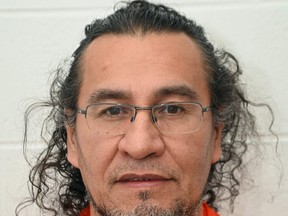
Article content
A newly-unsealed warrant for the DNA of cold case killer Joseph George Sutherland showed investigators had eliminated his four brothers as suspects, including going through garbage, before zeroing in on the youngest as the man who likely killed two women 40 years ago.
Advertisement 2
Article content
Sutherland, 69, pleaded guilty in October to two counts of second-degree murder in the 1983 sex slayings of Susan Tice and Erin Gilmour. His sentencing hearing was set to begin in January but has now been pushed to March 2024 due to a delay in a pre-sentence report.
Article content
The unsealed November 2022 information to obtain (ITO) by Toronto Police Det. Stella Karas made the fascinating case for why investigators needed a sample of his DNA.
The body of Tice, 45, was discovered in her Grace St. bedroom by her brother-in-law in August 1983. Naked but covered with a blanket, the social worker and mom to four teens had been stabbed multiple times in her chest and back.

Four months later and four kilometres away, the partially naked body of 22-year-old Erin Gilmour was found by her boyfriend in her Yorkville apartment at 9:20 p.m. on Dec. 20, 1983.
Article content
Advertisement 3
Article content
The aspiring fashion designer was last been seen alive working in the knit store downstairs at 8:45 p.m. Her hands had been bound behind her back with a scarf, a navy belt was around her neck and she’d also been stabbed in the chest.
Both women had lived alone; both women had been sexually assaulted, with semen found on both.

But the samples would have to wait until 2000 when scientific advances allowed them to be analyzed for DNA. In a stunning Jan. 3, 2001 report by the Centre of Forensic Science, the sperm DNA profile found on Tice matched the sample taken from Gilmour – linking the two murder cases for the first time.
The killer, though, would remain unknown for two more decades.
In 2019, Toronto Police decided to try the new technique known as investigative genetic genealogy (IGG), which uses information in public databases GEDmatch and FamilyTreeDNA and which Karras used in 2020 to identify the late Calvin Hooper as the killer of Christine Jessop.
Advertisement 4
Article content
After uploading the suspect DNA profile to the databases, forensic genealogist Det. James Atkinson got a list of persons whose genetic profiles overlapped that of the suspect. He then developed a family tree that led to the five Sutherland brothers as persons of interest.
An officer who worked in the northern indigenous community of Fort Albany and was first cousin to the Sutherlands recalled the brothers had all moved to Toronto with their mother but he couldn’t remember when.
Four of the five were eliminated as the source of the semen.
The oldest brother was dead and had been a convicted offender who’s DNA had been in the database and hadn’t registered a hit. The second had been killed in Moosonee and his DNA was also in the database and not a match.
Advertisement 5
Article content
In August 2021, OPP officers did a “garbage pull” from the third brother, taking two pop cans and a mask from his curbside trash. The DNA didn’t match their suspect.
A fourth brother was being investigated at his First Nations community for an unrelated reason and a plastic cup he used for water at the police station was taken for analysis. It also didn’t match the suspect DNA.
Recommended from Editorial
-

BREAKING: Ontario man pleads guilty to 1983 Tice and Gilmour murders in Toronto
-

HUNTER: Cops look to tech, DNA to solve 1991 Canada Day cabbie murder
-

MANDEL: Cold case killer to spend rest of life in jail
With four down and one to go, Joseph became their prime suspect – but they needed his DNA.
Since 2009, Sutherland had worked as an IT manager in the remote town of Moosonee close to the Arctic Circle that can only be reached in the winter by airplane or by “treacherous” ice road.
Advertisement 6
Article content
Two undercover OPP officers took the road – and later advised it was too dangerous to attempt again – to try and retrieve a “discard” sample of DNA but without success. There was no garbage outside to rifle through because residents take it to the local dump.
According to the ITO, his residence was so remote that there were no buildings to set up surveillance behind and they couldn’t surveil him in the community because a stranger would be easily identified. The OPP advised in April 2022 that getting a discard sample of Sutherland’s DNA was “unattainable.”‘
“I believe this investigative necessity is another factor making it in the best interests of justice to issue this DNA warrant.”
A judge agreed and with Sutherland’s DNA, the killer’s 40-year escape from the law came to an end.
mmandel@postmedia.com
Article content


